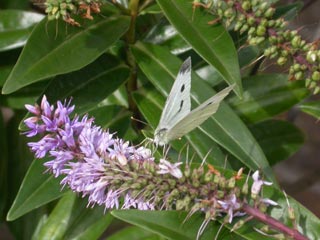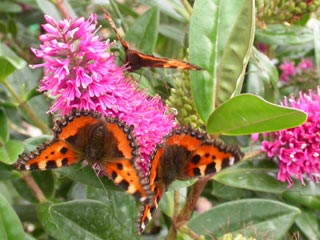Hebe
Shrubby Veronica
This plant attracts the following butterflies:
Brown Argus, Comma, Gatekeeper, Green-veined White, Holly Blue, Meadow Brown, Painted Lady, Peacock, Red Admiral, Small Tortoiseshell, Small White
Images of 2003:
 Small White on Hebe
Small White on Hebe
 Small Tortoiseshells on Hebe Josephine
Small Tortoiseshells on Hebe Josephine
Sightings 2005:
Peacock butterfly on Hebe, 5 August
Painted Lady butterfly,
5 August
Holly Blue butterfly, 16 August
Brown Argus on Hebe Josephine, 18 August
notes:
I have plenty of Hebe plants; many are without a name. It's quite easy to grow new plants from cuttings, which I have done, and also I inherited some Hebes in the present garden.
The flower spikes come in a range of shades of violet/mauve, pink and white and I've seen flowers on some of my plants during the winter months.
Hebes originate from New Zealand. The cold of an English winter can kill some varieties of this plant. I've found that the variegated-leafed ones and those with the larger leaves have been affected most. During February 2004, I wrapped several of my Hebes in hortricultural fleece to try to protect them from the worst of the cold.
Some Hebes need pruning to maintain a nice shape. The dead flower spikes can look rather ugly too, so dead-heading (removing dead flowers) is desirable.
Reference Section
Plant Type: hardy or slightly tender perennial shrub with evergreen leaves
Flowering time depends upon the particular variety
Height & spread: variable but 60cm-1.2m (2-4ft)
Position: Full sun with shelter from strong winds and hard frost. Smaller varieties are suitable for growing in pots.